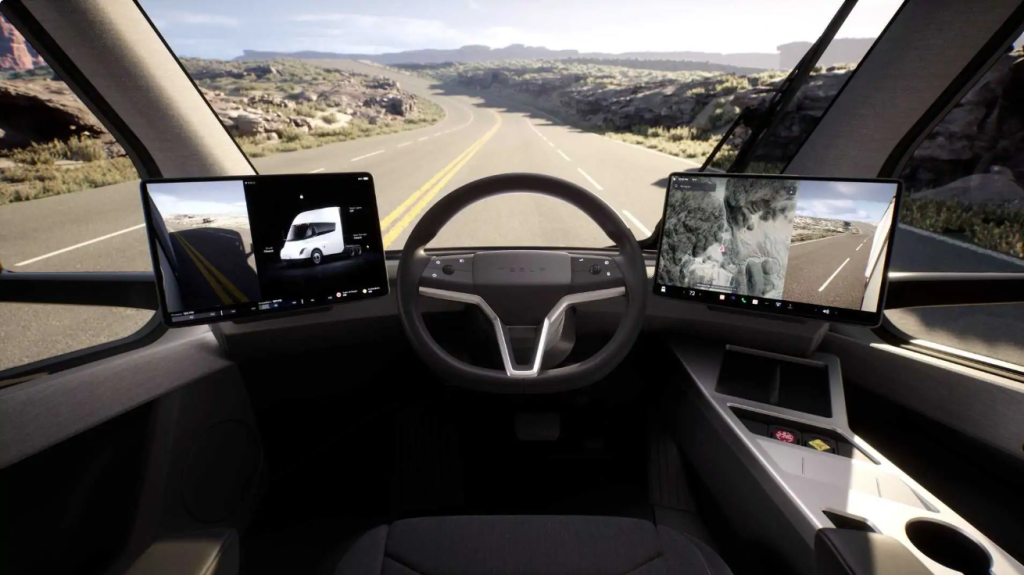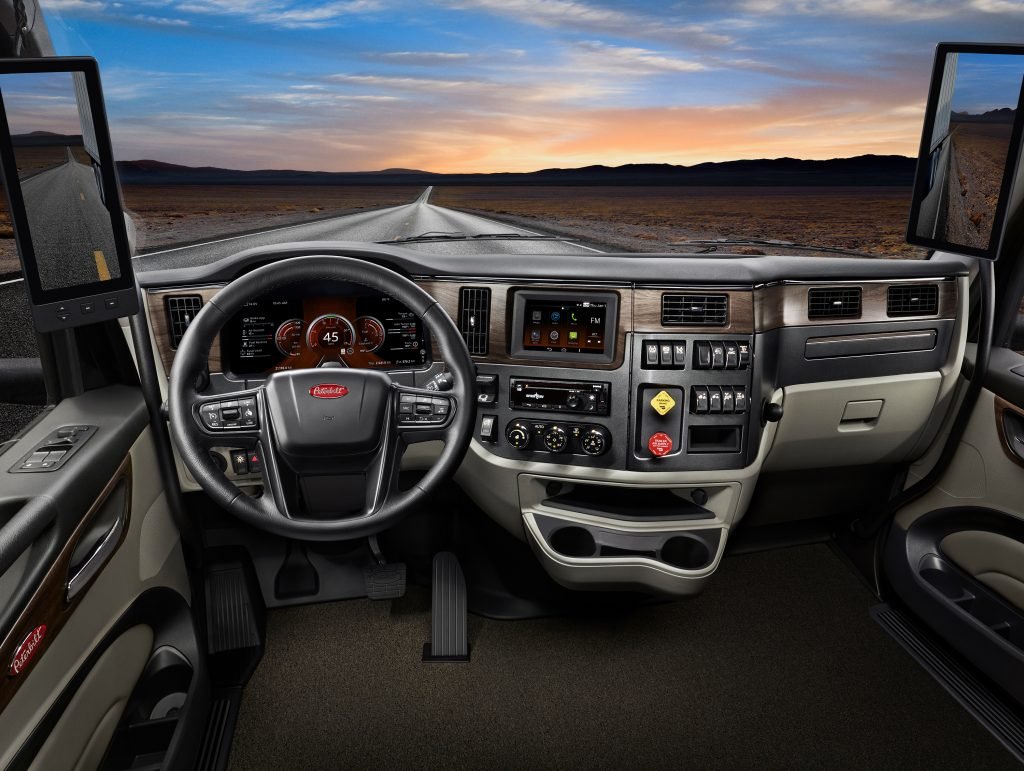Class 8 heavy duty trucks have always been known as a sector that’s hard to electrify. While passenger EV adoption is rapidly rising, electric semi adoption is still a few years behind. And its hard for heavy duty truck electrification to take off when Tesla hasn’t started mass production of it’s much anticipated Semi truck.
We think the Tesla semi truck will be a game changer for electrification. Not only is it electric, it’s better than the average diesel truck that you see on the road today. We think its better not because its electric, but because it offers a better driver experience without compromising on efficiency and price.
It’s hard to fully appreciate the Tesla Semi on its own, so we decided to do a comparison of the Semi with one of it’s diesel competitors, the Peterbilt 579. Diesel trucks like the Peterbilt 579 have long been the backbone of the freight industry. Rugged, powerful and reliable, they’ve earned their place as the go-to workhorses for long-haul fleets. This article compares the two in terms of driver comfort, performance, range and price. If you’re wondering whether your next big rig should be electric or diesel, read on.
Quick Comparison Table
| Feature | Tesla Semi (Electric) | Peterbilt 579 (Diesel) |
|---|---|---|
| Range | Up to ~500 miles (estimated) | ~1,200 miles (with dual tanks) |
| Fuel/Energy | Electricity | Diesel |
| Battery/Fuel Capacity | ~850–900 kWh | ~200 gallons diesel |
| Charging/Refueling Time | ~30 mins to 70% (Megacharger) | ~15 mins full diesel refill |
| Torque | Instant (electric motors) | Strong, but builds over RPM |
| Emissions | Zero tailpipe | High (NOx, CO₂, particulates) |
| Noise | Ultra quiet | Loud combustion engine |
Driver Comfort

This is where the Tesla Semi excels. Most of our readers may have already seen the interior of the Tesla Semi but its clear that the Tesla has completely changed the look and feel of a big rig cabin. Its not just the fancy touch screen, the aesthetics are classic Tesla and a class above anything that’s currently offered to long haul drivers. Not to mention the panoramic visibility which makes driving the truck a whole lot safer and easier.
The big innovation here is the centralized driver seat that adds to the driver experience. If you are concerned that the lack of a second seat or a sleeper cab, the Tesla semi does have a second seat, or a jump seat, along with the option for a sleeper cab.

There’s no doubt that if you’re a connoisseur of long haul diesel trucks, the Peterbilt 529 is one of the better trucks to drive and live in. The aesthetics are unsurprisingly a lot more traditional with analog controls, a left side drive, and more routine features like a swivel passenger seat, smart steering wheel, and an 80-inch sleeper berth for extended routes. While it may not match the Tesla Semi’s tech-forward layout, the 579 provides a familiar, functional environment that seasoned drivers appreciate.
While the Peterbilt is no doubt a proven winner with its functional analog design, we think Tesla’s timeless, minimalistic but tech forward design is the winner here. The Tesla touchscreens can get a bit of getting used to but once you spend enough time in it, it can be incredibly hard to move to anything else.
Performance
The Tesla Semi has three independent motors on its rear axles with one motor for cruising and two for torque. This results in instant throttle response, superior torque management, and smoother hill climbs, even under full 80,000 lb. loads. The batteries of the truck are located below the cab which lowers the low center of gravity and results in better handling than the average diesel truck. As with all electric vehicles, the electric motors provide for instant torque response and better traction which can be quite handy for drivers carrying 20 to 25 tons of payload.

The Peterbilt 579 relies on a diesel engine paired with either manual or automated transmissions. Power builds with RPMs, and gear changes are noticeable — especially on inclines. While experienced drivers may appreciate the control of a diesel setup, torque delivery is obviously delayed compared to an EV.
That said, Peterbilts are known for durable suspension systems, road-tested steering responsiveness, and a mechanical feel that seasoned operators often prefer. Their drivability improves with modern automated transmissions but still lags behind the seamless control of the Tesla Semi.
Range
No surprises here, the Peterbilt 529, like most diesel long haul trucks wins on raw range, capable of traveling over 1,000 miles on a full tank. The Tesla Semi, by contrast, has an estimated 500-mile on its larger battery trucks. While the Peterbilt clearly has the advantage on range, its important to remember than federal regulations require drivers to take a 30 minute break every 8 hours.
So even with a large fuel tank, the most a Peterbilt truck can go without refueling is approximately 500 miles (8 hours of driving at 60 miles an hour). That’s right, the limiting factor for range is often not the size of a battery or a fuel tank, it is usually regulations and of course, the size of your bladder!
Most drivers will say that’s great, but the Peterbilt completely removes the possibility of any range anxiety. Knowing that you have 1,000 miles left in your tank is extremely comforting but it’s also a bit of a luxury since you have truck refueling stations almost every 20 to 30 miles.
This is why its important for Tesla and other firms to have charging stations that are just as ubiquitous as diesel fuel stations. Tesla is building out its Megacharger network for this very purpose. The Megacharger which can charge at rates exceeding 1 MW can recharge the battery to 70% in around 30 minutes. This allows the driver to charge quickly without having to wait too long.
Price
Tesla hasn’t announced what the price of the Semi will be but that hasn’t stopped people from making educated guesses. People have tried to back into the price using publicly available documents. Two years ago Teslarati estimated the price of the Semi at around $250,000 which we think was an accurate number back then. We think the Tesla is going to be priced somewhere between $300,000 and $325,000. It isn’t going to be as cheap as a diesel truck but it isn’t going to as expensive as other electric trucks either, which tend to cost in excess of $400,000.
The diesel Peterbilt 529 is priced between $150,000 and $175,000, which is about $150,000 cheaper than the Tesla Semi. So if you were to just consider the upfront cost, it is going to be hard for the Tesla Semi or for any electric big rig to beat any long haul diesel truck.
But as most of you know, an electric truck saves a ton of money on both fuel and maintenance. We did some napkin math on these savings below and included the assumptions for everyone’s reference.
Fuel
On fuel we estimated annual savings of around $15,000. This assumed a charging rate of 30c per kWh which is a blended rate that includes both expensive, faster daytime charging (40c – 50c per kWh) and cheaper, slower overnight charging (10c – 20c per kWh).
Maintenance
We expect the Tesla Semi to eliminate two thirds of the maintenance expenses seen in diesel trucks. Remember, the entire internal combustion engine in a diesel truck gets replaced with a battery that needs very little maintenance. The only real maintenance expense for an electric truck will be related to the tires which may see more wear and tear because of the increased weight of the batteries.
| Category | Tesla Semi (1.7 kWh/mi, $0.30/kWh) | Peterbilt 579 (6.5 mpg, $4.25/gal) | Annual Savings |
|---|---|---|---|
| Annual Mileage | 100,000 miles | ||
| Energy/Fuel Cost | $51,000 | $65,385 | $14,385 |
| Maintenance Cost | $5,000 | $15,000 | $10,000 |
| Total Annual Operating Cost | $56,000 | $82,885 | $24,385 |
All in, that’s an annual savings of $24,385, which over 10 years is $243,850. So even if you spend an extra $150,000 on a Semi, you get paid that extra $150,000 back in 6-7 years. If you add these savings over 10 years to the higher up front cost of a Tesla Semi, the net cost of a Tesla goes down to $81,150 which is half the cost of a Peterbilt 529.
Net Effective Cost
| Truck | Base Price | 10 year savings | Estimated Net Cost |
| Tesla Semi | $325,000 | ($243,850) | $81,150 |
| Peterbilt Diesel | $175,000 | 0 | $175,000 |
We haven’t included the $40,000 tax credit (part of the Inflation Reduction Act) that is available to all buyers of an electric truck. If that’s included, the net cost of a Tesla goes down to just $41,150!
So while the Tesla Semi has a higher sticker price, operational savings and incentives help offset it within a few years.
Payload
The Tesla Semi has a gross vehicle weight rating (GVWR) of up to 82,000 lbs thanks to a federal 2,000-lb EV exemption, but its massive battery pack adds extra weight compared to a diesel truck. As a result, its payload capacity is around 6,000 lbs lower than that of a Peterbilt 579. For fleets running weight-sensitive routes, this could be a key consideration. Or if you are driver trying to optimize for the maximum weight you can carry, this is a bit of a concern. However, for many haulers where trucks “cube out” (have no space left) before they “weigh out,” the difference may have minimal real-world impact.
| Specification | Tesla Semi (500-mile) | Peterbilt 579 Diesel |
|---|---|---|
| Gross Vehicle Weight Rating (GVWR) | 82,000 lbs (with 2,000-lb EV exemption) | 80,000 lbs (standard U.S. limit) |
| Estimated Tractor Weight | ~26,000–28,000 lbs | ~18,000–20,000 lbs |
| Estimated Payload Capacity | 54,000–56,000 lbs | 60,000–62,000 lbs |
Conclusion
The Tesla Semi is a breath of fresh air for long-haul drivers. It is a step up in driver experience and comfort and if you are on the road for more than ten hours a day, even small improvements are going to go a long way. The improved performance and the handling will also make life a lot easier when towing a 30,000 lb load.
We think the bigger impediment to adoption of electric trucks is not necessarily the higher up front cost or the perceived lack of range, but the charging network. If we had a world were you saw Tesla Megachargers every fifty miles, haulers wouldn’t have to think twice about getting an electric truck. We aren’t there yet but we will get there!